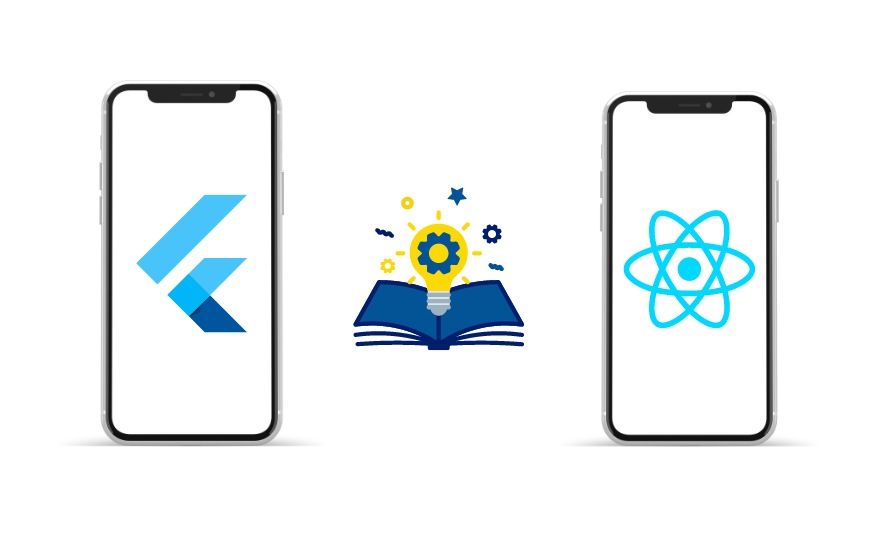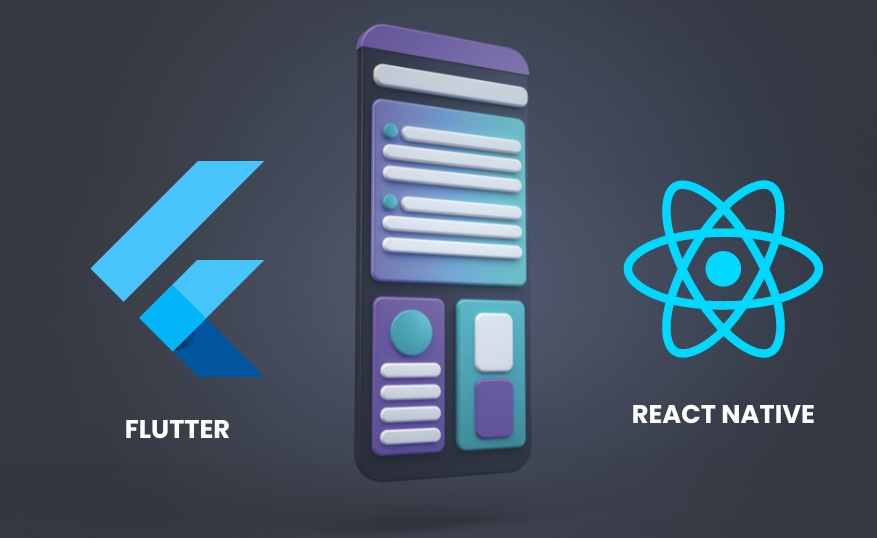Table of Contents
When building a mobile app, businesses often ask – What’s best for us, Flutter or React Native? These two frameworks are the most popular since businesses are more into cross-platform apps, which are cost-effective and less time-consuming than developing native apps for two separate platforms.
Today, mobile apps are a crucial component in our daily lives, as recent stats show that mobile apps generated 171 billion U.S. dollars. So, it is important to decide which framework to select for app development in Flutter vs. React Native. Let’s dive deep and find out what’s best for your business needs.
Understanding Flutter and React Native

Flutter
Flutter is an open-source UI software development kit (SDK) developed by Google. It enables developers to build natively compliant applications for mobile, web, and desktop with a single codebase. It was released in 2017 and has been popular in the developer community since.
Key Features of Flutter
- Single Codebase: With Flutter, you can use a single codebase for multiple platforms. It’s like writing once and running anywhere!
- Dart Programming Language: It uses Dart which is developed by Google and offers a fast, object-oriented approach.
- Hot Reload: Using Flutter, you will be able to see code changes in real-time without restarting the application.
- Rich Set of Widgets: Provides a comprehensive set of customizable widgets that conform to specific design languages (e.g., Material Design, Cupertino).
React Native
React Native is an open-source framework, developed by Facebook that enables developers to build mobile applications using JavaScript and React. It was first introduced in 2015, and developers have widely adopted it due to its flexibility and performance.
Key Features of React Native
- JavaScript and React: It utilizes JavaScript, one of the most popular programming languages, and React, a powerful library for building user interfaces.
- Native Components: Developers can use native components with React Native, which enables them to create a native-looking app.
- Hot Reloading: Just like Flutter, it allows developers to see the results of the latest change instantly.
- Large Community: React Native benefits from a vast community and a rich ecosystem of libraries and tools. You can find support from several developers.
Performance Comparison

One of the top factors to consider when selecting the best technology for custom mobile app development is its performance in mobile application development. On comparing the performance of Flutter vs. React Native, it could be seen that while overall performance is quite similar, some distinctions ought to be discussed.
Flutter Performance
Flutter’s advantage is its high speed of displaying even complex graphics, achieved through native ARM code. This means that Flutter applications function effectively and perform well, in some cases, as well as native applications.
Another aspect is that the given framework provides a widget-based architecture that positively rotates the basis for its work and gives a solid advantage concerning most narrow approaches that regulate every pixel on the screen.
React Native Performance
React Native has reasonably good performance and works as a native app, but it uses a bridge between JavaScript and native modules. This can sometimes allow performance bottlenecks since the schedule can be overbooked, particularly with large applications that require extensive computational power.
However, UI efficiency is adequate for most ordinary uses, and recent updates to React Native have been aiming to optimize the bridge and decrease overhead.
Development Experience

When choosing between Flutter vs. React Native, experience is also an important aspect to consider since it impacts productivity, a learning curve, and, therefore, the developers’ satisfaction.
Flutter Development Experience
- Dart Language: Unlike JavaScript, Dart is not as well-known; Nonetheless, it is quite simple to master, primarily for programmers with an object-oriented background.
- Comprehensive Documentation: Numerous tutorials for Flutter make it easy for developers to get started and find answers to the questions they have.
- Hot Reload: Flutter has greatly improved hot reload, which makes it easier for developers to alter or change the codes in real-time without relaunching the whole application.
- Customizable Widgets: Flutter comes with a rich set of widgets that allow developers to have complete control over the output UI by delivering visually receptive applications.
React Native Development Experience
- JavaScript and React: Using popular languages and modules like JavaScript and React makes React Native easily approachable to many developers.
- Extensive Libraries and Tools: It is also important to know that the React Native environment has many libraries and tools that can help with certain tasks or add functionality.
- Hot Reloading: Hot reloading in React Native is a great tool as it helps to observe the effects of changes right away during development, time efficiency and productivity.
- Native Modules: This means native modules can be utilized while creating apps with React Native, which is beneficial since developers can include native code in specific instances.
Cost of Development
Another consideration is the development cost which greatly impacts the businesses and developers whenever choosing the framework.
Flutter Cost of Development
In the case of Flutter, the single codebase approach makes sense because such a framework helps avoid the development of different teams and, thus, the need to spend more money.
It also states that the framework’s elements, including an efficient development process and a large number of ready-made widgets, can contribute to reducing required time and costs. In the same regard, Flutter’s simple construct and good performance can also help reduce the optimization demands and, therefore, the costs.
React Native Cost Of Development
From a cost perspective, React Native is also beneficial because it can reuse the code between an iOS and an Android application. There is a huge amount of support in the form of libraries and tools available that could further help make development easier and less costly.
From a cost perspective, React Native is also beneficial because it can reuse the code between an iOS and an Android application. There is a huge amount of support in the form of libraries and tools available that could further help make development easier and less costly.
However, performance optimization and handling of some probable bridge bottlenecks would consume extra time and resources.
Use Cases and Suitability

It’s difficult to say if one is better and the other is not. Both frameworks have strengths and weaknesses – choosing between Flutter and React Native ultimately depends on the specific requirements and goals of the project.
Flutter Use Cases and Suitability
Flutter is great for applications that must be fast, look good, and have consistent behavior across different platforms. It is particularly well-suited for:
- Applications that require rich animations, quick drawing, and a high level of personalization.
- Tasks with highly specialized UI designs that need to align with certain design languages that do not necessarily relate to an application as a whole.
- Software development teams initially need to create fast proofs of concept and digital products with one design.
React Native Use Cases and Suitability
React Native is best for you if you are aiming for fast development cycles, broad developer accessibility, and integration with existing JavaScript codebases. It is particularly appropriate for:
- Applications that require more libraries and third-party plugins to be integrated into the framework because of the extensive React Native ecosystem.
- Building mobile versions of Web applications for which there are already ActionScript and React codebases.
- Every application needs to be developed for both the iOS and Android cultures so that it has compatible code and works similarly.
Future Prospects

Flutter’s Future
Flutter actively develops and receives frequent updates and additions. Based on what has been seen prior, especially Google’s dedicated support for Flutter along with an ever-growing circle and community, the future seems promising for Flutter. Its capability to support web and desktop applications extends the list of possibilities even further.
React Native’s Future
React Native still stands its ground with constant innovation and definite support from Facebook. The availability of features like Hermes and maintaining future updates also show its relevance. The current widespread of React Native for developing various entities shows that it is steady in its popularity and incorporation.
Conclusion
Flutter and React Native are both highly effective frameworks for developing cross-platform applications for mobile devices. While they have some similarities, some significant differences need to be considered when choosing the right technology.
Some of the areas in which Flutter is especially strong are performance, UI flexibility, and bringing platform parity to development. Some strengths of React Native include the reusability of existing JavaScript and React, a large repository, and accelerated development.
When choosing between Flutter vs. React Native, consider your project’s requirements and hire a professional mobile app development services USA, which can be very helpful. By carefully evaluating these factors, you can select the framework that best aligns with your goals and sets your mobile app development project up for success.



Add a Comment